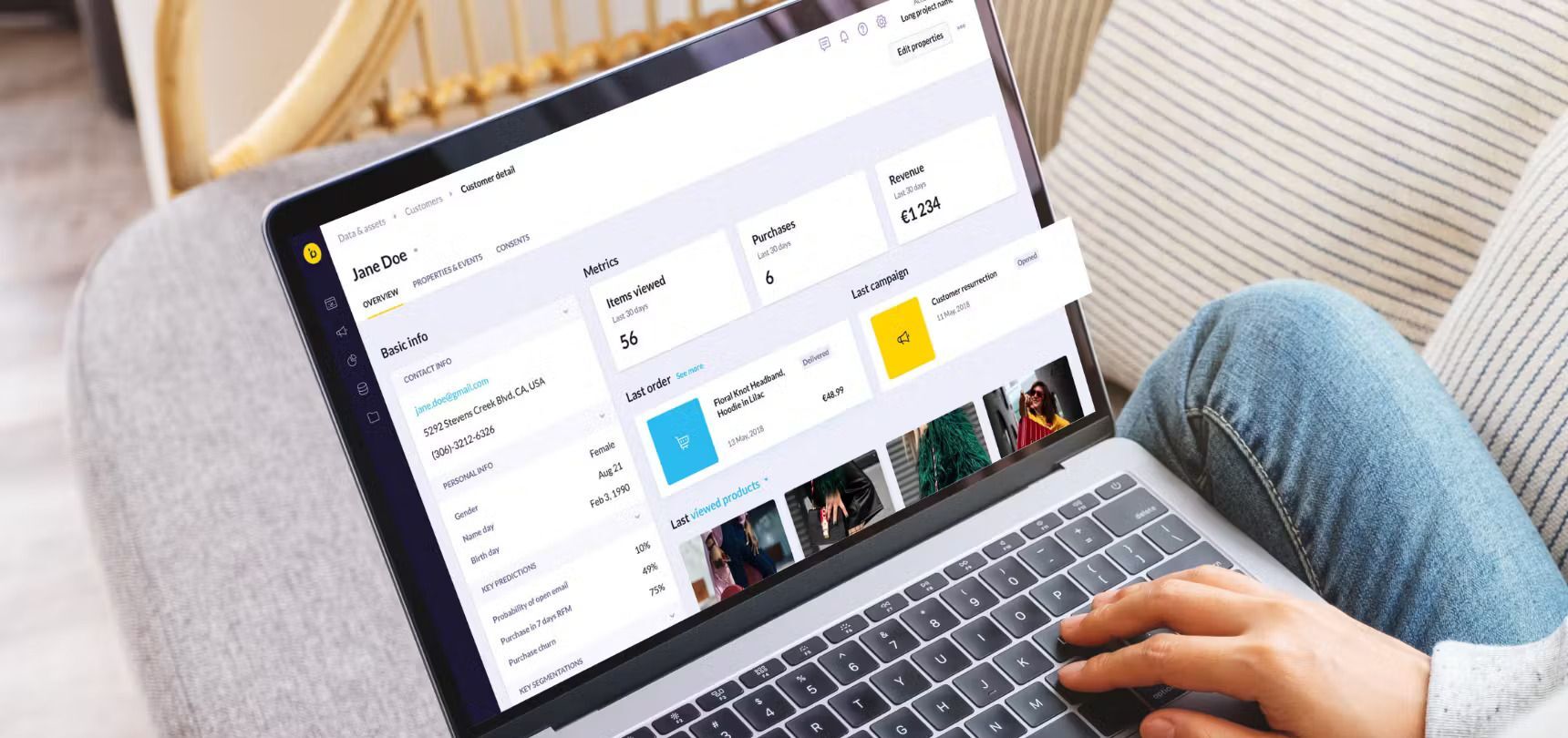Winning With a MACH Personalization Strategy
By Donna-Marie Bohan
03/29/2024

In the fast-paced world of ecommerce, staying ahead of the curve is essential for success. One of the most powerful tools in a retailer and brand’s arsenal is personalization. Tailoring the shopping experience to individual customers can significantly enhance engagement, satisfaction, and ultimately, sales. But to truly excel in this realm, businesses must leverage cutting-edge technologies. That's why a MACH (microservices, API-first, cloud-native, headless) personalization strategy is so important. In this article, we'll explore how MACH can revolutionize your ecommerce operations, from understanding its power to overcoming challenges and envisioning its future impact.
The Importance of a Personalization Strategy in Ecommerce
Personalization lies at the heart of successful ecommerce ventures. Customers today expect tailored experiences that cater to their unique preferences and behaviors. From product recommendations to targeted promotions and content, personalization can drive engagement, foster loyalty, and increase conversions. Achieving effective personalization, however, requires more than just intuition — it demands sophisticated technologies and strategies.
That’s where MACH comes in. MACH represents a modern approach to building and deploying software applications. This architecture emphasizes agility, scalability, and flexibility, making it an ideal fit for the dynamic world of ecommerce. By decoupling components and leveraging cloud infrastructure, MACH enables businesses to adapt quickly to changing market demands and deliver exceptional user experiences.
A Brief Overview of MACH

To break this down further, here are some simple definitions to explain MACH technologies:
- Microservices — Individual pieces of business functionality that are independently developed, deployed, and managed, allowing for maximum flexibility
- API-first — All functionality is exposed through an API so that you can tie multiple applications or services together
- Cloud-native SaaS — This software-as-a-service uses the cloud to full advantage, going beyond storage and hosting to include elastic scaling and automatic updates
- Headless — The front-end user experience is decoupled from the back-end logic, giving you complete freedom and agility in framework and programming language
In short, MACH technologies are composable and decoupled microservices that are API-based, cloud-driven, and headless. It’s a modern, modular tech approach that separates the ecommerce platform's front end from the back end.
The MACH Alliance is a not-for-profit, vendor-neutral industry organization that advocates for the best enterprise technologies that adhere to MACH standards. Members of the MACH Alliance include Bloomreach, along with a range of vendors, system integrators, and enablers, and each one has been vetted to ensure they can provide the scalability and flexibility needed to navigate a changing commerce landscape. So when you see a MACH-certified technology, you know you’re getting the best composable commerce experience possible.
The Power of a MACH Personalization Strategy
But how exactly does a MACH architecture support ecommerce personalization? At its core, MACH architecture empowers personalization by providing the infrastructure needed to collect, analyze, and act on customer data in real time.

With microservices, each aspect of an ecommerce platform can operate independently, allowing for granular customization and rapid iteration. An API-first approach ensures seamless integration with third-party systems, enabling access to a wealth of data sources for enhanced personalization. Cloud-native solutions offer scalability and reliability, ensuring consistent performance even during peak traffic periods like Black Friday or the holiday season. Plus, by embracing a headless commerce model, businesses gain the flexibility to deliver personalized experiences across various touchpoints, from websites to mobile apps and beyond.
Steps To Implement a MACH Personalization Strategy
Implementing a MACH personalization strategy involves several key steps, each aimed at leveraging the principles of MACH architecture to deliver personalized experiences to users. Here's a detailed guide to implementing a MACH personalization strategy:
Understand Customer Behavior
The foundation of any successful personalization strategy is a deep understanding of customer behavior. By leveraging data analytics tools and techniques, businesses can gain insights into user preferences, browsing patterns, purchase history, and more. Armed with this knowledge, retailers and brands can segment their audience effectively and tailor their offerings to match specific interests and needs.
Create Personalized Content Using Microservices and an API-first Approach
With MACH architecture, personalization becomes a seamless process. Microservices enable the creation of highly targeted content modules that can be dynamically assembled based on user attributes and context. By exposing these services through APIs, developers can integrate personalized content into various touchpoints, such as product pages, search results, and marketing emails, ensuring a cohesive and engaging shopping experience.

Use Cloud-Native Solutions To Deliver Personalized Experiences
Cloud-native solutions play a crucial role in the delivery of personalized experiences. By using cloud infrastructure, businesses can scale their operations efficiently to meet growing demand while minimizing downtime and performance issues. Additionally, cloud-based analytics tools enable real-time data processing and decision-making, allowing retailers and brands to deliver relevant content to customers at the right moment.
Implement Headless Commerce
A headless commerce system offers unparalleled flexibility and agility in personalization. By decoupling the front-end presentation layer from the back-end commerce logic, businesses can experiment with new features and experiences without disrupting core operations. This enables rapid iteration and innovation — a very important consideration in today’s ever-changing tech and consumer landscape — and ensures that personalized content remains fresh and engaging over time.
Test and Learn
You’ll want to make sure you run tests to evaluate the effectiveness of different personalization strategies, content variations, and recommendation algorithms. Additionally, you can gather feedback from users through surveys, interviews, and usability testing to identify areas for improvement and refinement. Iterating on personalization strategies based on data-driven insights and user feedback will continuously improve the effectiveness and relevance of personalized experiences. By staying tuned to emerging technologies, industry best practices, and customer preferences, you’ll also be in a strong position to innovate and evolve your MACH personalization strategy over time.
By following these steps, you can effectively implement a MACH personalization strategy and deliver compelling, tailored experiences to users across various channels and touchpoints, driving engagement, loyalty, and revenue growth.
Challenges in Implementing a MACH Personalization Strategy
Despite its many benefits, implementing a MACH personalization strategy can pose some challenges. These may include technical complexities associated with microservices architecture, integration issues with legacy systems, data privacy and security concerns, and organizational resistance to change.
How To Overcome These Challenges
Businesses must adopt a holistic approach that addresses both the technical and organizational aspects of implementing a MACH personalization strategy.
Consider some of the following steps:
- Invest in robust data management and integration solutions
- Foster a culture of innovation and experimentation
- Prioritize customer privacy and security at every stage of the development process
- Seek guidance from experienced partners and leverage best practices to help accelerate the implementation and adoption of MACH personalization strategies
At Bloomreach, we also partner with composable commerce leaders like Orium to offer support from implementation through optimization, ensuring a seamless move to MACH architecture.
The Future of Ecommerce With MACH Personalization
Looking ahead, MACH personalization has the potential to reshape the ecommerce landscape in profound ways. As technology continues to evolve, we can expect to see increasingly sophisticated personalization algorithms and techniques that deliver hyper-targeted experiences tailored to individual preferences and contexts.
We’re already seeing this play out with artificial intelligence. 92% of companies are looking at AI for personalization and data-driven personalization can deliver 5-8x the ROI on marketing spend. That means you’ll need to adopt AI technology if you hope to keep up with consumer expectations around personalization and efficiency.
With MACH architecture, you can benefit from the seamless integration of AI into your technology stack, offering the flexibility to incorporate AI applications smoothly and experiment with them without causing disruptions to your regular operations. Whether opting for incremental adoption or a complete replatforming, you have the freedom to select the AI-driven technologies that best suit your needs, empowering you to gain a competitive edge in today's market without having to wait for extensive overhauls from your development team within a monolithic architecture framework.
A MACH personalization strategy holds the key to unlocking the full potential of ecommerce in the digital age. By combining cutting-edge technologies with customer-centric strategies, businesses can deliver personalized experiences that delight customers, drive conversions, and fuel long-term success. With careful planning, strategic execution, and a commitment to innovation, ecommerce professionals can position their brands for sustained growth and relevance in an ever-changing marketplace.
See for yourself first-hand how top brands have found success with a MACH-led strategy.
Found this useful? Subscribe to our newsletter or share it.







